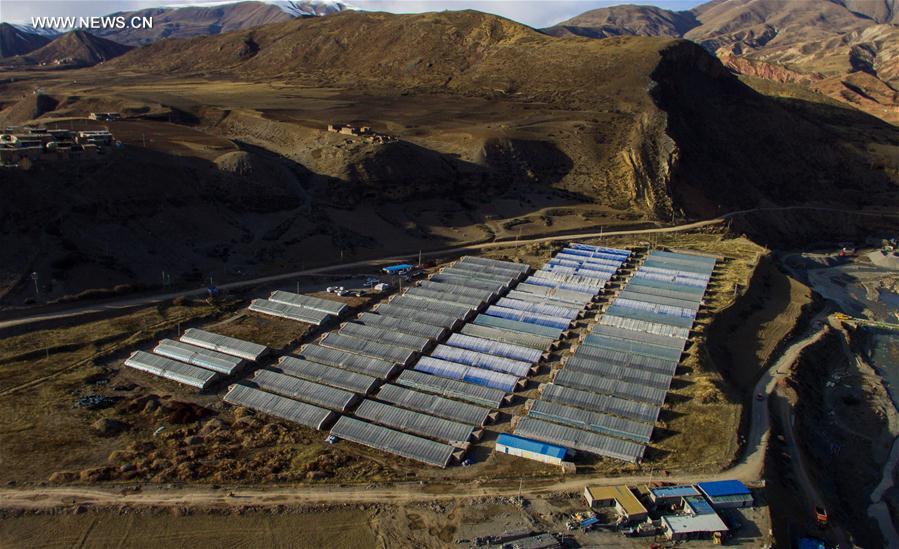
Tibetans plant highland barley in Nyingchi City, Tibet Autonomous Region, SW China, March 2018. /VCG
Tibetans plant highland barley in Nyingchi City, Tibet Autonomous Region, SW China, March 2018. /VCG
Known as the roof of the world, the Tibetan Plateau, with its extreme altitudes, relentless winds and harsh weather, can be uninhabitable for people.
Barley, which is frost hardy and cold tolerant, is thus the lifeline for Tibetans. Having a mechanism to survive harsh mountainous conditions, it has been a consistent source of food for Tibetans for thousands of years. Therefore, it accounts for a huge part of the Tibetan diet – it is grounded into flour and roasted to make tsampa, a common traditional staple food.
Barley cultivation was also a major source of income for farmers in Tibet. Originally cultivated by small-scale farmers who would use manual techniques to seed and harvest, it was sold at a very low price – maximum of 2 yuan (around 30 U.S. cents) per 500 grams. But things have changed with the industrial transformation in recent years.
"When we first arrived in Tibet, there was barely any sizeable barley processing company in the region. Little automation was employed and the productivity was very low," Wang Fengzhong, director of the Institute of Food Science and Technology at Chinese Academy of Agricultural Sciences, told CGTN.

A local farmer shows stalks of a highland barley called "Zangqing 2000" in Bainang County, Shigatse, Tibet, China, September 7, 2013. /Xinhua
A local farmer shows stalks of a highland barley called "Zangqing 2000" in Bainang County, Shigatse, Tibet, China, September 7, 2013. /Xinhua
Due to low levels of oxygen in the region, relying on manual labor for harvesting and processing was inefficient. Wang, together with scientists at the Tibet Academy of Agricultural and Animal Husbandry Sciences, sought to introduce large-scale automation to the barley processing companies.
The company that they selected for a pilot run was Deqin Sunshine Manor, a barley deep processing company in Shigatse City of the Tibet Autonomous Region. In 2016, new factories were built, and new conveyor belts and machinery were installed. Rather than solely focusing on producing ground barley as the main staple food, the company specializes in processing barley into high value-added products, such as dietary supplements and snacks.
With an increase in processing efficiency, the company's demand for raw barley skyrocketed. Each year, over 50,000 tonnes of barley were purchased by the company from Tibetan farmers.
"The price of barley set by the company is above the market price, at around 2.4 yuan per 500 grams, which means that farmers can have 0.4 yuan per 500 grams as earnings," said a Tibetan farmer, and now an employee at Deqin Sunshine Manor, in an interview with CCTV. Her family was once deeply mired in poverty, but now because of the job opportunity and the purchase scheme from the company, she has a monthly salary of around 5,000 yuan and her family has rid itself of the poverty-stricken status.
According to Chinese media reports, more than 2,000 deeply impoverished Tibetan residents were lifted out of poverty by collaborating with the company starting 2019.
The transformation of the barley processing industry is part of the state's efforts to develop agricultural businesses for poverty alleviation. A number of barley processing factories were later established in regions close to poverty-stricken areas in Tibet to provide jobs as well as sources of income to local farmers and residents. Greenhouse vegetable planting was also introduced to add to the variety of crops that local farmers can cultivate and rely on.

Vegetable greenhouses in Xiemai Village of Dengqen County in Qamdo, Tibet, China, November 4, 2017. /Xinhua
Vegetable greenhouses in Xiemai Village of Dengqen County in Qamdo, Tibet, China, November 4, 2017. /Xinhua
With the introduction of automation, the annual output of barley in Tibet increased dramatically, rising to 795,000 tonnes in 2020, an all-time high.
Critical to the increase of barley output, apart from the introduction of high-tech processing equipment and automation, was the discovery of high-yielding barley.
Nyima Tashi, Tibet's chief scientist of highland barley crop breeding and the former head of the Tibet Academy of Agricultural and Animal Husbandry Sciences, was the principal promoter of high-yielding barley varieties in the region.
One of his major discoveries was Zangqing 2000, a high-yielding barley breed that accounted for more than half of the acreage of highland barley planted in Tibet. After the high-yielding variety was seeded, farmers were able to sell their surplus crop to local barley processing companies, spurring the growth of companies in the field to more than a few hundred in 2019.
Containing ample nutrients, such as protein, fiber, minerals and B vitamins, food produced from barley can help lower cholesterol, control blood sugar and reduce the risk of chronic and metabolic diseases. Barley's high tolerance for frost and dehydration made it an ideal crop to ensure food security on the Tibetan plateau.

